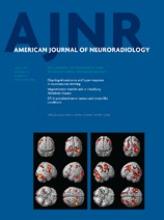Abstract
BACKGROUND AND PURPOSE: Antiplatelet therapy is associated with decreased ischemic events after neurointerventional procedures. Antiplatelet resistance negates the protective effects of antiplatelet medication, leading to a higher incidence of ischemic events. A possible link between antiplatelet hyper-response and increased hemorrhagic complications has been inadequately investigated. We aimed to examine the correlation between antiplatelet hyper-response and the risk of hemorrhagic complications.
MATERIALS AND METHODS: Patients who were treated with antiplatelet medications and underwent neurointerventional procedures were prospectively recruited. We collected the following data: demographics, vascular risk factors, antiplatelet and anticoagulation treatment, antiplatelet responsiveness, coagulation profile, and hemorrhagic complications. P2Y12 receptor–mediated platelet inhibition was tested by using the VerifyNow assay device. The primary end points were postprocedural major and minor hemorrhagic complications. Receiver operator characteristic analysis was used to evaluate the percentage of platelet inhibition as a diagnostic tool for bleeding events. The association between hemorrhage and percentage of platelet inhibition was investigated by using logistic regression modeling.
RESULTS: Forty-seven patients were enrolled. The mean age was 56 ± 12 years, and 28% were men. Ten patients (21.3%) developed hemorrhagic complications. Clopidogrel response was higher in patients with a major bleeding complication compared with those with minor or no bleeding (median, 94% versus 24% platelet inhibition; P = .0084). Of the 7 patients (14.9%) defined as hyper-responders with ≥72% platelet inhibition, 42.8% had a major bleeding complication.
CONCLUSIONS: Hyper-response to clopidogrel is associated with increased risk of hemorrhagic complications. Larger studies are urgently needed to validate a clinically useful threshold to define clopidogrel hyper-response and to examine the clinical effects of antiplatelet dosage adjustment.
ABBREVIATIONS:
- ACT
- activated clotting time
- aPTT
- activated partial thromboplastin time
- CI
- confidence interval
- IQR
- interquartile range
- ROC
- receiver operating characteristic
- © 2013 by American Journal of Neuroradiology












